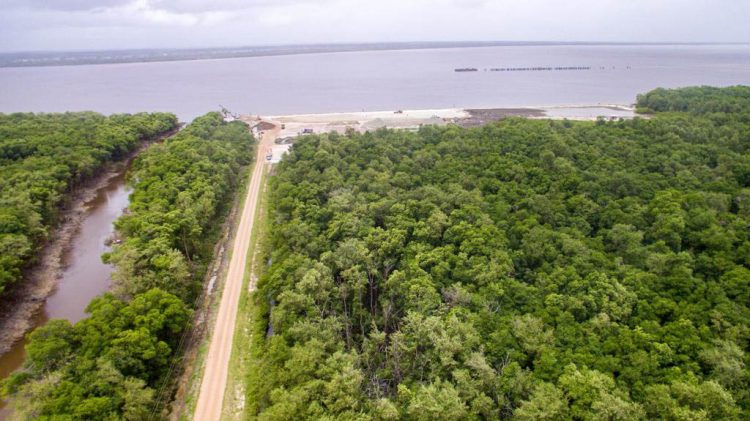A vast swathe of mangroves has been cleared from the eastern bank of the Berbice River adjacent to Crab Island to facilitate the development and construction of Guyana’s first deep water port by Canadian owned CGX Energy Inc.
While the company has announced its intention to preserve some 10 acres mangroves on the 30-acre plot at Corentyne, Berbice it acquired for the project, there has been no disclosure of the percentage of mangroves cleared to date to facilitate the development.
A visit to the location last week by this newspaper revealed that preparatory works have been progressing at the location and aerial images that were commissioned showed land filling was underway.

An entire stretch of land that was once a swamp is now backfilled with white sand and a rip rap sea defence has been installed on the bank of the river to prevent erosion.
Persons familiar with the area where the facility is being built confirmed that mangroves had to be destroyed to facilitate the development.
When this newspaper questioned the company’s Executive Chairman Dr Suresh Narine last month about the amount of mangroves that were removed for the development of the project, he refused to say. “As a publicly-traded company, we only speak publicly first to the market and then to other newspapers. I am afraid you will have to wait until we make a further announcement. Hope you understand,” he said in a brief response to the questions posed by Stabroek News.
Chairman of the River and Sea Defence Board Gary Beaton, when contacted Stabroek News recently, said he was not aware of the project and would have to find out. Follow up calls by this newspaper went unanswered.
The board comprises key agencies, such as the Environmental Protection Agency and the National Agriculture and Research and Extension Institute (NAREI), which have oversight over the protection of mangroves. It would be within its mandate to issue a permit to the company to remove mangroves which are protected by law here.
At the level of the Borlam-Kintyre Neighbourhood Demo-cratic Council (NDC), Stabroek News learnt that there was no discussion of the removal of the mangroves. It was explained that while the lands fall under the boundaries of the NDC, they are regarded as state lands, which the local authority has no control over. Due to this, there was no discussion about the removal of mangroves and the proposed usage.
Further, Stabroek News learned that the building plans submitted by the company to the NDC did not mention the quantity of mangroves it planned to remove.
Last Month, Narine announced plans by the company to retain 10 acres of old-growth mangroves at the site.
However, he posited that “If we want to see progress, we’ve got to disturb the environment somehow. But if we’re going to do that, we must disturb it as intelligently and as carefully as we can.” His comments were made during his presentation at the International Energy Conference at the Marriott Hotel.
The deep water port is being constructed aback Seawell Village, Corentyne, Berbice and the civil works are being carried out by the company’s subsidiary, Grand Canal Industrial Estates Inc (GCIE). The deep water port facility will cost a total of US$80 million.
At the time, Dr Narine explained that the facility would sit on 30 acres of land and a Memorandum of Understanding (MoU) would soon be signed to retain 10 acres of mangroves on the plot. Pointing out that Berbice is known for its swamps and agricultural lands, Dr Narine said that when developing facilities, like the port, environmental considerations should be put in place. Nevertheless, he said that some environmental degradation is required in the furtherance of economic growth.
“…those [standing mangroves] are effectively going to be the source of an MOU that’s about to be signed, where we look at the coexistence of mangrove habitats with commercial activity on our rivers…through those 20 acres we have 400 meters of frontage,” he said.
Narine, during the commissioning of a bridge that leads to the site last December, announced “Very important — of the 30 acres that we have out there, we have earmarked 10 of those acres to be a living laboratory of mangroves habitat to study how habitats can co-exist with commercial development.”
Providing an update on the deep water port, Dr Narine said that the construction of docks and dredging would begin very shortly while the selection of the engineering, procurement and construction (EPC) contractors was underway.
The port, when completed, is expected to have an offshore supply component that will provide essential support to offshore oil and gas operations.
Just last year a large swathe of mangrove forest was destroyed at Malgre Tout/Versailles on the West Bank of Demerara by a shore base investor –TriStar Investment.
Government had justified the move to grant approval for the removal of the mangroves.
“The PPP/C in its approach towards the development of the country has said repeatedly: we will not be obstructionists; we will be facilitating and we have facilitated and will continue to facilitate developmental projects once it comes in a framework where it is properly regulated, sustainable, where there is no danger to life and livelihood, and where we can see the creation of jobs and this project fits within that framework,” Public Works Minister Juan Edghill had said after the destruction.





